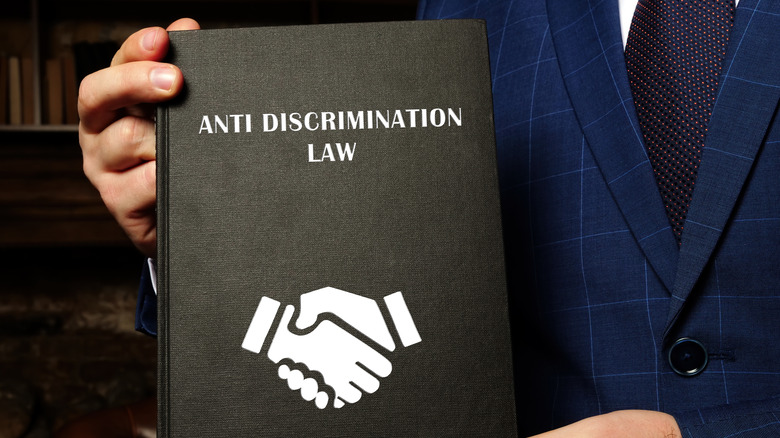Why Armchair Detectives Think Laurie 'Bambi' Bembenek Was Framed For Murder By The Police
Laurie Bembenek gained national attention in 1990 after her escape from the Taycheedah Correctional Institution where she was serving her sentence for murder. The story of how she ended up in prison and her escape was so intriguing that it became the subject of books and movies. When it comes to her guilt, many are divided to this day. Was Bembenek guilty of committing murder, or was she wrongfully convicted?
Bembenek's case had all the elements of an interesting Hollywood movie. She was a beautiful woman who worked in law enforcement and was accused of murdering the ex-wife of her new husband. Throughout the years, armchair detectives have pored over the details of the case, and many believe that the authorities framed her. Bembenek was adamant that she had nothing to do with the murder, and she stayed firm in her statement and repeatedly tried to clear her name until her death.
Who was Laurie Bembenek?
Laurie Bembenek was born in Milwaukee and was the youngest of three children. From an early age, she showed independence. She played the flute for her school band and excelled in running. After high school, Bembenek studied fashion merchandising, and although she was a beautiful woman who turned heads wherever she went, she was a tomboy at heart, as noted by Milwaukee Magazine. When she turned 21 years old, Bembenek decided to work in law enforcement. For a year, she went through training and tests and was accepted at the Milwaukee Police Department in 1980.
Bembenek's choice to work in law enforcement impacted her romantic life. She had a serious boyfriend who wanted to marry her, but he also wanted her to be a housewife and take care of their future children. The relationship ended when Bembenek said that she never wanted to have children and that she wanted to establish her career before getting married. However, her work at the police department was short-lived. According to Bembenek, she was subjected to harassment and abuse during her training period, and she claimed that some of the people she worked with were sexist.
The discrimination complaint
During her training to become an officer, an anonymous individual alleged that Laurie Bembenek smoked marijuana during a party. The claim was investigated but was never substantiated. Later on, however, she was fired for allegedly filing a false police report, according to The Washington Post. Bembenek felt that her life was spiraling out of control. According to her, she was unjustly fired, and she couldn't get a position in other police departments. She resorted to babysitting and was able to secure work as a security guard.
Bembenek also worked on filing a discrimination complaint against the Milwaukee Police Department. She came across photos of police officers — both men and women — dancing nude at a party sponsored by a tavern. She took the photos to the Equal Employment Opportunity Commission (EEOC) and said that while she had been fired for a minor offense that wasn't proven, the officers in the photos who clearly violated police department rules were still employed and went unpunished. As reported by the Milwaukee Magazine, the EEOC advised Bembenek to submit copies of the photos police department's internal affairs, as she had a compelling discrimination case.
Laurie Bembenek's relationship with Elfred Schultz
Elfred "Fred" Schultz was a detective at the Milwaukee Police Department, and he was also one of the people photographed nude in the photos Laurie Bembenek submitted to the EEOC. Schultz also knew one of the women that Bembenek babysat for. The two started spending time together, and after a two-month courtship, they married in a civil ceremony in January 1981. According to Bembenek's friend, JoAnne Shields, Schultz partied hard, was a jokester, and was loud (via Oxygen). Schultz was 10 years older than Bembenek and had two children with his ex-wife, Christine Schultz.
As reported by Vanity Fair, however, the relationship between Bembenek and Schultz quickly deteriorated. Money was tight and the couple planned to move to a cheaper apartment. In addition, Schultz was paying for mortgage and child support to his ex-wife which amounted to almost half of his monthly salary. Months later, Christine Schultz was murdered, and Bembenek was charged with the crime.
The murder of Christine Schultz
On May 28, 1981, Christine Schultz was found dead in her home. Her wrists were tied and a bandanna was tied around her face. Christine died of a gunshot wound in her back. As reported by Oxygen, Christine's son Sean, who was 11 years old, woke up as an intruder was attempting to tie a rope around his neck. His screams woke up his 8-year-old brother, Shannon. Sean said the attacker then headed to his mother's room, and that's when he heard a gunshot. He described the assailant as having a red ponytail. He wore a green top and had black shoes that looked like the ones that police officers wore.
Fred Schultz was called to the scene together with his partner, Michael Durfee. Since Fred was the victim's ex-husband, he was immediately questioned. He said that he had been working on a case when the murder happened. Later on, however, it was discovered that Fred lied about his alibi. He was, in fact, drinking at a bar while on the job. Per Vanity Fair, Fred was asked to turn in his gun to the investigators. Bembenek, on the other hand, said that she had been at home asleep when the murder occurred. When the ballistics test results on Schultz's gun came out, it revealed that it was the murder weapon used to kill Christine, and Bembenek was charged with first-degree murder and arrested six days later.
Laurie Bembenek maintained her innocence
According to prosecutors, Laurie Bembenek's motive for killing Christine Schultz was money. Fred Schultz's financial responsibilities to his family were eating into their finances, and that was why Bembenek decided to kill Christine. Prosecutors stated that Bembenek wore a disguise, entered Christine's home using Fred's key, and killed her (via Vanity Fair). They argued that Bembenek was the only other person who had access to Fred's gun. A wig was also found in plumbing underneath the apartment she shared with Fred, and its fibers were consistent with those found on Christine's body.
The jury found Bembenek guilty, and she was sentenced to life in prison. Fred divorced her soon after. As reported by Milwaukee Magazine, Bembenek earned a bachelor's degree while incarcerated, and she even started a newspaper for the inmates. As years passed, Bembenek's appeals were repeatedly denied, and she had lost all hope of ever getting out. She had a romantic relationship with Dominic Gugliatto, the brother of a fellow inmate, and with his help, she escaped the prison through a window in July 1990 after eight years in prison. When news of Bembenek's escape broke, many supported Bembenek, and hundreds of people gathered together donning "Run Bambi Run" shirts. "Bambi" was the nickname the media gave Bembenek during the trial, a name she despised. As reported by AP News, many believed that Bembenek's trial was unfair and that she was innocent. Her supporters even donated money to pay for her legal team.
Her recapture and final years
Laurie Bembenek was able to evade authorities for three months before she was recaptured in Ontario. She went back to prison where she was sent to solitary confinement for seven months. Bembenek's attorney pushed for a new trial, but what she got was an offer instead. According to Milwaukee Magazine, Bembenek would be released on parole on the condition that she plead no contest to second-degree murder. In legal terms, no contest means the defendant waives the right to have a trial and accepts the sentence given by the court. The plea doesn't admit guilt; it just means that the defendant will not contest the charges (via Cornell Law School). Bembenek decided to accept the offer, and she was released in 1992.
Despite gaining her freedom, Bembenek pushed for the reversal of her conviction. She was adamant that she was innocent and was framed by the Milwaukee Police Department for her role in assisting in the investigation of discrimination and corruption in the department. When asked why she pleaded no contest, Bembenek said that her parents were old and sickly, and that was the only way she would be able to spend time with them, as reported by The New York Times. She added that her father wanted to see her name cleared before his death. Bembenek died of liver failure in 2010 at the age of 52. She worked with her lawyers to clear her name until her final years.
Was Laurie Bembenek innocent?
Many details have been revealed since Laurie Bebanek's conviction, and the information lead many to believe she was wrongfully convicted. One former Milwaukee detective who spoke anonymously to Vanity Fair stated that the department had a meeting after Christine Schultz's death. "There are a lot of cops throughout the department who feel that meeting was where Bambi's fate was sealed. They needed a fall guy — don't ask me why — and that fall guy was Bambi," he said. In 2019, Bembenek's lawyer also noted that news DNA and ballistics tests conducted proved that Bembenek was innocent. The results showed a male DNA, who they believe is the real killer (via TMJ4). A 2006 ballistics test also showed that the bullet that killed Christine wasn't fired from Schultz's gun.
As reported by Milwaukee Journal Sentinel, though the jury convicted Bembenek of murder, the pieces of evidence presented were circumstantial. Both she and Fred Schultz had access to the murder weapon and the wig. In addition, Christine's son, Sean, testified in court that he didn't believe that Bembenek was who he saw on the night of the attack, as reported by Vanity Fair. Many armchair detectives believe it was Fred who killed his ex-wife, or perhaps he hired someone to do the deed. When asked who she thought killed Christine, Bembenek said she had an idea but said she wouldn't name names. "I would never say it out loud, because I would never want anybody to go through what I went through," she said. As of 2019, her lawyer was still seeking a posthumous pardon for her.







